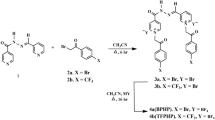Abstract
In the present work, a theoretical study of five bipyrazolic-type organic compounds, 4-{bis[(3,5-dimethyl-1H-pyrazolyl-1-yl)methyl]-amino}phenol (1), N1,N1-bis[(3,5-dimethyl-1H-pyrazol-1-yl)methyl}]-N4,N4-dimethyl-1,4-benzenediamine (2), N,N-bis[(3,5-dimethyl-1H-pyrazol-1-yl)methyl]aniline (3), 4-[bis(3,5-dimethyl pyrazol-1-yl-methyl)-amino]butan-1-ol (4) and ethyl4-[bis(3,5-dimethyl-1H-pyrazol-1-yl-methyl) aminobenzoate] (5), has been performed using density functional theory (DFT) at the B3LYP/6-31G(d) level in order to elucidate the different inhibition efficiencies and reactive sites of these compounds as corrosion inhibitors. The efficiencies of corrosion inhibitors and the global chemical reactivity relate to some parameters, such as EHOMO, ELUMO, gap energy (ΔE) and other parameters, including electronegativity (χ), global hardness (η) and the fraction of electrons transferred from the inhibitor molecule to the metallic atom (ΔN). The calculated results are in agreement with the experimental data on the whole. In addition, the local reactivity has been analyzed through the Fukui function and condensed softness indices.




Similar content being viewed by others
References
Sastri VS (1998) Corrosion inhibitors—principles and applications. Wiley, Chichester, England
Growcock FB (1989) Corrosion 45:1003–1007
Frisch MJ, Trucks GW, Schlegel HB, Scuseria GE, Robb MA, Cheeseman JR, Zakrzewski VG, MonTgomery JA, Jr, Stratmann RE, Burant JC, Dapprich S, Millam JM, Daniels AD, Kudin KN, Strain MC, Farkas O, Tomasi J, Barone V, Cossi M, Cammi R, Mennucci B, Pomelli C, Adamo C, Clifford S, Ochterski J, Petersson GA, Ayala PY, Cui Q, Morokuma K, Malick DK, Rabuck AD, Raghavachari K, Foresman JB, Cioslowski J, Ortiz JV, Stefanov BB, Liu G, Liashenko A, Piskorz P, Komaromi I, Gomperts R, Martin RL, Fox DJ, Keith T, Al-Laham MA, Peng CY, Nanayakkara A, Gonzalez C, Challacombe M, Gill PMW, Johnson BG, Chen W, Wong MW, Andres JL, Head-Gordon M, Replogle ES, Pople JA (2003) Gaussian 03, Revision B.05. Gaussian Inc., Pittsburgh
Tebbji K, Aouniti A, Benkaddour M, Oudda H, Bouabdallah I, Hammouti B, Ramdani A (2005) Prog Org Coat 54:170–174
Elayyachy M, Elkodadi M, Aouniti A, Ramdani A, Hammouti B, Malek F, Elidrissi A (2005) Mater Chem Phys 93:281–285
Tebbji K, Oudda H, Hammouti B, Benkaddour M, El kodadi M, Malek F, Ramdani A (2005) Appl Surf Sci 241:326–334
Lopez N, Illas F, Phys J (1998) Chem B102:1430–1436
Lee C, Yang W, Parr RG (1988) Phys Rev B37:785–789
Ignaczak A, Gomes JANF (1996) Chem Phys Lett 257:609–615
Lashkari M, Arshadi MR (2004) Chem Phys 299:131–137
Parr RG, Donnelly RA, Levy M, Palke WE (1978) J Chem Phys 68:3801–3807
Parr RG, Pearson RG (1983) J Am Chem Soc 105:7512–7516
Yang W, Parr RG (1985) Proc Natl Acad Sci USA 82:6723–6726
Parr RG, Yang W (1984) J Am Chem Soc 106:4049–4050
Yang W, Mortier WJ (1986) J Am Chem Soc 108:5708–5711
Becke AD (1993) J Chem Phys 98:5648–5652
Lee C, Yang W, Parr RG (1988) Phys Rev B37:785–789
de Proft F, Martin JML, Geerlings P (1996) Chem Phys Lett 256:400–408
Fukui K, Yonezawa T, Shingu H (1952) J Chem Phys 20:722–725
Hackerman N, Snavely Jr E, Payne Jr JS (1966) J Appl Electrochem 113:677–681
Sastri VS, Perumareddi JR (1997) Corros Sci 53:617–622
Ögretir C, Mihçi B, Bereket G (1999) J Mol Struct: Theochem 488:223–231
Lukovits I, Kálmán E, Zucchi F (2001) Corrosion 57:3–8
Khalil N (2003) Electrochim Acta 48:2635–2640
Lukovits I, Pálfi K, Bakó I, Kálmán E (1997) Corrosion 53:915–919
Pearson RG (1988) Inorg Chem 27:734–740
Pearson RG (1963) J Am Chem Soc 85:3533–3539
Dewar MJS, Thiel W (1977) J Am Chem Soc 99:4899–4907
Acknowledgements
The author wishes to acknowledge financial support from the Scientific Research Fund of Hunan Provincial Education Department (no. 05A002), the Prominent Mid-youth Science and Technology Foundation of Hunan Province (grant no. 04JJ1010), and the Cross Project of Xiangtan University (no. 05IND07) for the research work.
Author information
Authors and Affiliations
Corresponding author
Rights and permissions
About this article
Cite this article
Wang, H., Wang, X., Wang, H. et al. DFT study of new bipyrazole derivatives and their potential activity as corrosion inhibitors. J Mol Model 13, 147–153 (2007). https://doi.org/10.1007/s00894-006-0135-x
Received:
Accepted:
Published:
Issue Date:
DOI: https://doi.org/10.1007/s00894-006-0135-x




